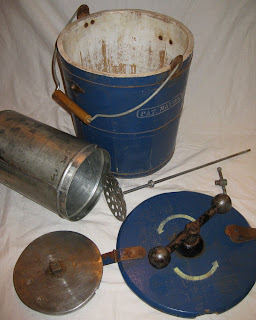 |
| Close, But No Cigar |
Okay, so it really wasn't a dare, it was more like a challenge. It all started with a request from my friend Susie Webb. Susie is a dedicated historian and fellow volunteer at Columbia State Historic Park. During our annual Living History event known as Columbia Diggins' 1852, Susie portrays the proprietress of the American Hotel. The Hotel is known for its excellent cuisine as well as a place of lodging for weary miners. Several years ago, she asked me what an ice cream freezer would have looked like in 1852. At the time of the Gold Rush, there was a demand for just about everything in California. It's known that ice was brought down from the Sierra Nevada mountains early on and marketed as a product. Since ice is one of the key ingredients necessary to make ice cream in a freezer, it's logical to think that the treat was available in some of the multitude of restaurants that sprang up. It's well documented that emmigrants crossing the plains made ice cream and even commented on it being available in Salt Lake City in 1854. Susie not only wanted to offer ice cream to her clientele but she also wanted to interpret the making of ice cream, if it could be produced in a period correct Ice Cream Freezer. My challenge was to research and recreate that historic freezer.
 |
| The First Patented Ice Cream Freezer Only the Paddles Moved On This Version of 1843 |
 |
| Young's Improved Freezer Two Parts in Motion On This Model of 1848 |
 |
| Cookbook Illustration and Caption of Young's Freezer in Common Use by 1854 |
The cookbook illustration showed me what an actual 1850's freezer probably looked like, at least to the artist who made the woodcut. The patent drawings, as you can see, focused more on the mechanics of the device. After considerable time searching for an actual surviving example of an original Young's Freezer, I finally gave up. Most collections of antique freezers seem to only go back as far as the late 1800's. It does make sense though, when you think how popular ice cream is, that the early ones are probably used up. With only the drawings to go on, I had my work cut-out for me. I already had a nicely coopered bucket that was a fair match to the cookbook picture. I managed to score a vintage inner container from an older White Mountain Freezer that fit nicely into my bucket. I redesigned the lid of the cannister to lock into place. As far as replicating the mechanics I relied on my blacksmith friend George Cantrell to turn up a nicely weighted handle from a large clamp and some other misc. iron that he combined to produce the large spanner on top of the lid. I fabricated what remained including the bucket lid, handle and plunger. Through trial and error, it was discovered that the bucket's lid needed to be locked down in some fashion in order for the freezer to function as originally designed. Even though my version of this freezer is not a replica of an actual original freezer, I did try to limit the conjectural elements in order to honestly represent the original device.
 |
| My Recreation of Young's Freezer Photos Lindy Miller 2011 |
 |
| Exploded View, Showing Inner Container and Plunger |
After 5 years of service at Living History events, my recreated historic freezer is still going strong and successfully creating delicious ice cream or so I've been told since I'm usually too late for the samples. The lesson for interpreters here is that through the use of carefully researched recreations, the curious visitor may be drawn in by something familiar (ice cream) and end up gaining insight into history through a rare and unique experience. Was that fun or what?
 |
| Susie Webb and a Young Helper Columbia Diggins' 1852 Photo Courtesy CA State Parks |
Well, I wish I could try some of that delicious ice cream considering all the time and effort you spent on creating a close replica of the original patent model.
ReplyDeleteSo how did I end up on this blog? Well, long-story-short, I am sad about a hole in a dress identical to one I purchased from Lindy years ago. I am looking for a replacement or the pattern if it is available.
It was a dress that buttoned part-way down the front, had drop sleeves, plain neck, with two side back panels, a center back seam, and ties to be tied in the back. I love my dress and want another one as it is not fitted around the waist and allows for a pound or two of wt. gain or loss.
If Lindy knows what I am referring to, have her email me with a source for the dress or a pattern company.
Thanks Jim for the ice cream. I am sure it was wild blackberry in flavor. Also thanks for passing on the message to Lindy.
Take care; take joy!
Susan Okey
docent at Marshall Gold